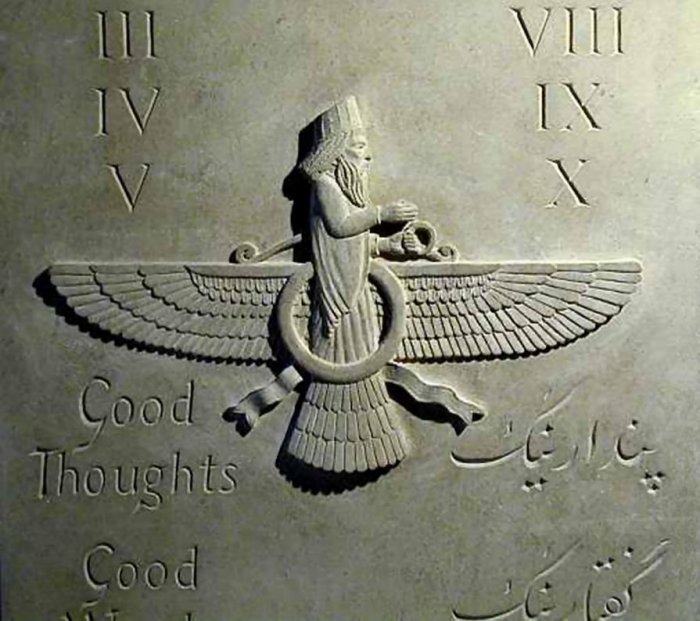Three Judges Of Souls Await You On Chinvat Bridge – Gateway To Unknown Realms In Zoroastrian Beliefs
Ellen Lloyd - AncientPages.com - The concept of death, soul, and afterlife have long fascinated humans. Like modern scientists keep speculating about what happens when we die, ancient civilizations had their own beliefs about what death really means. Invisible bridges leading to unknown realms are mentioned in many myths and legends.
Most ancient people did not consider death to be the ultimate end of existence. The vision of some sort of afterlife was shared by many of our ancestors.
Ancient Beliefs About An Invisible Bridge Leading To Unknown Realms
The idea that there was an invisible bridge between heaven and the earth can be encountered in the mythology of many different peoples. As author Michael P. Berman points out in his book, A Bridge to the Other Side “ in Borneo, the passage for souls to heaven is across a long tree; it is scarcely practicable to any except those who have killed a man.
Three judges of souls wait on the Chinvat bridge. Credit: AncientPages.com
In Burma, among the Karens, they tie strings across the rivers for the ghosts of the dead to pass over to their graves. In Java, a bridge leads across the abyss to the dwelling-place of the gods; the evil-doers fall into the depths below. Among the Esquimaux, the soul crosses an awful gulf over a stretched rope until it reaches the abode of "the great female evil spirit below the sea."
The Ojibways cross to paradise on a great snake, which serves as a bridge. The Choctaw bridge is a slippery pine log. The South American Manacicas cross on a wooden bridge. Among many of the American tribes, the Milky Way is the bridge to the other world.
Readers of Ancient Pages familiar with Norse Mythology will remember the story about the rainbow bridge Bifrost (Bifröst) that ends under the shade of the mighty world-tree Yggdrasil. Bifrost is said to connect heaven and Earth. This sacred place is guarded by God Heimdallr, who illuminated the world. The rainbow bridge serves as a passage between Asgard, the realm of Norse Gods and Midgard, home of humans.
The rainbow bridge Bifröst reminds a little of the Chinvat Bridge that we encounter in Zoroastrian beliefs.
Three Judges Of Souls Stand On The Chinvat Bridge
According to Zoroastrianism, one of the world's great ancient religions, humans are always faced with a choice between the path of 'good' and 'evil'. How we behave in life decides what happens after death. After the end of the human journey, the souls arrive at the Chinvat crossing, where God Mithras (Covenant) represents one of the three judges of souls. The other two judges are Sraosha, "Conscience" and "Observance" and Rashnu, Justice. Nothing you have done or thought escaped these three judges, no matter how much you try to hide your sins.
The Chinvat Bridge, also known as the "bridge of judgment" is guarded by two four-eyed dogs. The bridge serves as a portal separating the world of the living from the world of the dead.
Ahura Mazda is the creator and sole God of Zoroastrianism, the old Iranian religion that spread across the Middle. Credit: Public Domain
The crossing of the bridge depends on one’s actions in life. Those who have been wicked and evil will find themselves standing on a narrow bridge where they will encounter the demon Vizaresh who will drag the damned souls into the druj-demana (the House of Lies). It’s a place similar to the Christian version of Hell where a person must suffer eternal punishment.
To good and kind people, the Chinvat Bridge will be wide enough to cross. On their way to the other side, the righteousness will be met by the Daena. The Daena leads all good souls into the House of Song where they are united with Ahura Mazda, the creator God in Zoroastrianism. It’s a spirit representing revelation.
Zoroastrianism and Christianity are similar in their beliefs about the fate of the souls. When a person dies, the three spiritual components in Zoroastrian beliefs (the soul, fravashi and spirit) continue to exist in another invisible realm. The destination of the spirit depends on the kind of life one has lived from the age of fifteen.
The judgment of the souls at the Chinvat bridge involves testing and all person deeds are taken into consideration, including thoughts and spoken words.
In a way, one can say that a deceased person cannot hide anything when confronted with the judges at the Chinvat Bridge. The judges of souls see through you.
Written by Ellen Lloyd – AncientPages.com
Copyright © AncientPages.com & Ellen Lloyd All rights reserved. This material may not be published, broadcast, rewritten or redistributed in whole or part without the express written permission of AncientPages.com and Ellen Lloyd
Expand for referencesMore From Ancient Pages
-
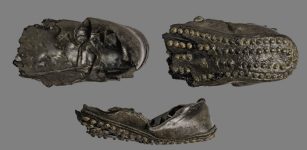 1,700-Year-Old Roman Shoes And An Exceptional Glass Workshop Unearthed In France
Archaeology | Jun 5, 2023
1,700-Year-Old Roman Shoes And An Exceptional Glass Workshop Unearthed In France
Archaeology | Jun 5, 2023 -
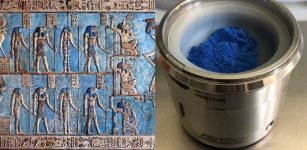 Ancient Egyptian Blue Used To Create New Nanomaterial 100,000 Times Thinner Than A Human Hair
Ancient Technology | Mar 24, 2020
Ancient Egyptian Blue Used To Create New Nanomaterial 100,000 Times Thinner Than A Human Hair
Ancient Technology | Mar 24, 2020 -
 Face Of Norwegian Boy Who Lived 8,000 Years Ago Reconstructed
Archaeology | Mar 16, 2023
Face Of Norwegian Boy Who Lived 8,000 Years Ago Reconstructed
Archaeology | Mar 16, 2023 -
 Unknown Highly Advanced Civilization Created Malta’s Cart Ruts With Sophisticated Machinery
Ancient Technology | Apr 26, 2014
Unknown Highly Advanced Civilization Created Malta’s Cart Ruts With Sophisticated Machinery
Ancient Technology | Apr 26, 2014 -
 Largest Capstone Ever Found In South India
Archaeology | Mar 24, 2017
Largest Capstone Ever Found In South India
Archaeology | Mar 24, 2017 -
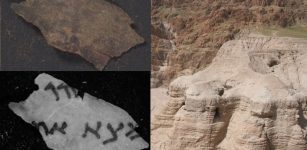 Hidden Text Discovered On Dead Sea Scrolls Reveals An Unknown Manuscript Is Still Missing
Archaeology | May 5, 2018
Hidden Text Discovered On Dead Sea Scrolls Reveals An Unknown Manuscript Is Still Missing
Archaeology | May 5, 2018 -
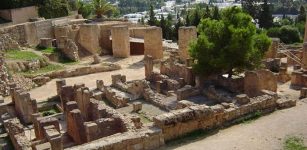 Carthage: Prosperous Phoenician Colony That Became Dominant Power In The Western Mediterranean
Featured Stories | May 21, 2020
Carthage: Prosperous Phoenician Colony That Became Dominant Power In The Western Mediterranean
Featured Stories | May 21, 2020 -
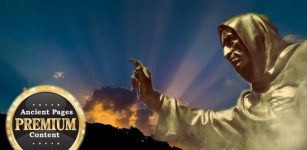 Unexplained Lights Over English City Reported By Police May Have A Deeper Meaning
Featured Stories | Dec 11, 2019
Unexplained Lights Over English City Reported By Police May Have A Deeper Meaning
Featured Stories | Dec 11, 2019 -
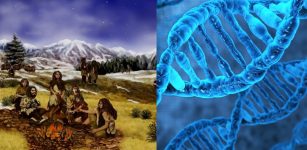 Neanderthal DNA Still Influence Modern Human Genes – Scientists Say
Archaeology | Mar 3, 2017
Neanderthal DNA Still Influence Modern Human Genes – Scientists Say
Archaeology | Mar 3, 2017 -
 Millennia-Old Sumerian Tripod Vase Dedicated To God Ningirsu, The Son OF Enlil
Archaeology | Oct 6, 2016
Millennia-Old Sumerian Tripod Vase Dedicated To God Ningirsu, The Son OF Enlil
Archaeology | Oct 6, 2016 -
 Ryujin: Benevolent And Righteous Dragon-King And Sea God In Japanese Legends
Featured Stories | Jun 10, 2024
Ryujin: Benevolent And Righteous Dragon-King And Sea God In Japanese Legends
Featured Stories | Jun 10, 2024 -
 Saraswati – Hindu Goddess Of Knowledge, Learning And Vedic Symbol Of Speech, Vach
Featured Stories | Jun 23, 2021
Saraswati – Hindu Goddess Of Knowledge, Learning And Vedic Symbol Of Speech, Vach
Featured Stories | Jun 23, 2021 -
 Golden Stool Of Ashanti People And Legend Of The Black Cloud Appearing In The Sky
African Mythology | Dec 8, 2025
Golden Stool Of Ashanti People And Legend Of The Black Cloud Appearing In The Sky
African Mythology | Dec 8, 2025 -
 7,000-Year-Old Underwater Wall Discovered Off French Coast – Has The Mythical Submerged City Of Ys Been Found?
Archaeology | Dec 12, 2025
7,000-Year-Old Underwater Wall Discovered Off French Coast – Has The Mythical Submerged City Of Ys Been Found?
Archaeology | Dec 12, 2025 -
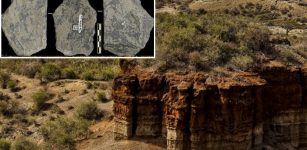 Olduvai Gorge: Direct Cosmogenic Nuclide Dating Of Olduvai Lithic Industry
News | Mar 31, 2022
Olduvai Gorge: Direct Cosmogenic Nuclide Dating Of Olduvai Lithic Industry
News | Mar 31, 2022 -
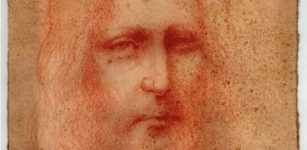 Unknown Sketch Of Jesus Christ By Leonardo Da Vinci Could Be The Holy Grail Of Art
News | Nov 24, 2020
Unknown Sketch Of Jesus Christ By Leonardo Da Vinci Could Be The Holy Grail Of Art
News | Nov 24, 2020 -
 Strange Case Of The ‘Impossible’ Glove Remains Unexplained – The Discovery – Part 1
Featured Stories | May 24, 2019
Strange Case Of The ‘Impossible’ Glove Remains Unexplained – The Discovery – Part 1
Featured Stories | May 24, 2019 -
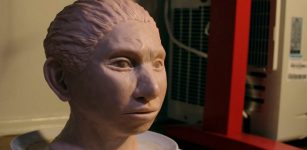 Skull Of Mysterious, Extinct Cousin Of Neanderthals Recreated From A Fossilized Finger
Archaeology | Sep 19, 2019
Skull Of Mysterious, Extinct Cousin Of Neanderthals Recreated From A Fossilized Finger
Archaeology | Sep 19, 2019 -
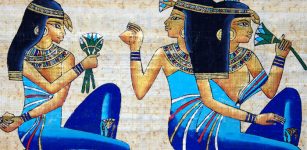 Ancient Scents Can Be Reconstructed With Help Of Modern Science – Researchers Say
Archaeology | Mar 28, 2022
Ancient Scents Can Be Reconstructed With Help Of Modern Science – Researchers Say
Archaeology | Mar 28, 2022 -
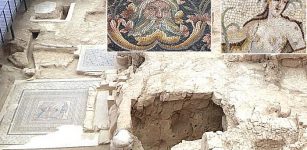 Rock-Cut Chambers In “House of Muses” Of Zeugma, Home To Numerous Mosaics
Archaeology | Jul 27, 2021
Rock-Cut Chambers In “House of Muses” Of Zeugma, Home To Numerous Mosaics
Archaeology | Jul 27, 2021


